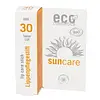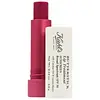What's inside
What's inside
 Key Ingredients
Key Ingredients

 Benefits
Benefits

 Concerns
Concerns

 Ingredients Side-by-side
Ingredients Side-by-side

Pongamia Glabra Seed Oil
Skin ConditioningCera Alba
EmollientTheobroma Cacao Seed Butter
EmollientButyrospermum Parkii Butter
Skin ConditioningTitanium Dioxide
Cosmetic ColorantRicinus Communis Seed Oil
MaskingCopernicia Cerifera Cera
EmollientPolyglyceryl-3 Polyricinoleate
EmulsifyingHydrogenated Coco-Glycerides
EmollientHippophae Rhamnoides Oil
EmollientCocos Nucifera Oil
MaskingPunica Granatum Seed Oil
EmollientSqualane
EmollientPrunus Persica Fruit Extract
AbrasiveStearic Acid
CleansingAlumina
AbrasiveAroma
Tocopherol
AntioxidantPongamia Glabra Seed Oil, Cera Alba, Theobroma Cacao Seed Butter, Butyrospermum Parkii Butter, Titanium Dioxide, Ricinus Communis Seed Oil, Copernicia Cerifera Cera, Polyglyceryl-3 Polyricinoleate, Hydrogenated Coco-Glycerides, Hippophae Rhamnoides Oil, Cocos Nucifera Oil, Punica Granatum Seed Oil, Squalane, Prunus Persica Fruit Extract, Stearic Acid, Alumina, Aroma, Tocopherol
Cocos Nucifera Oil
MaskingHelianthus Annuus Seed Oil
EmollientCera Alba
EmollientCandelilla Cera
EmollientRicinus Communis Seed Oil
MaskingOctocrylene
UV AbsorberEthylhexyl Methoxycinnamate
UV AbsorberButyrospermum Parkii Butter
Skin ConditioningTheobroma Cacao Seed Butter
EmollientHydrogenated Coco-Glycerides
EmollientButyl Methoxydibenzoylmethane
UV AbsorberCopernicia Cerifera Cera
EmollientGarcinia Indica Seed Butter
Skin ConditioningSqualane
EmollientLimnanthes Alba Seed Oil
Skin ConditioningHydrogenated Vegetable Oil
EmollientCitrus Limon Peel Oil
MaskingPrunus Amygdalus Dulcis Oil
Skin ConditioningLimonene
PerfumingTocopherol
AntioxidantXimenia Americana Seed Oil
EmollientCitrus Medica Limonum Peel Extract
EmollientStevia Rebaudiana Extract
Alumina
AbrasivePEG-8
HumectantLauroyl Lysine
Skin ConditioningGlycine Soja Oil
EmollientCitral
PerfumingAscorbyl Palmitate
AntioxidantCitric Acid
BufferingAscorbic Acid
AntioxidantCI 77891
Cosmetic ColorantMica
Cosmetic ColorantCI 77491
Cosmetic ColorantCI 77492
Cosmetic ColorantCI 77499
Cosmetic ColorantCI 45410
Cosmetic ColorantCI 73360
Cosmetic ColorantCI 15850
Cosmetic ColorantCI 17200
Cosmetic ColorantCI 77120
Cosmetic ColorantCI 19140
Cosmetic ColorantCocos Nucifera Oil, Helianthus Annuus Seed Oil, Cera Alba, Candelilla Cera, Ricinus Communis Seed Oil, Octocrylene, Ethylhexyl Methoxycinnamate, Butyrospermum Parkii Butter, Theobroma Cacao Seed Butter, Hydrogenated Coco-Glycerides, Butyl Methoxydibenzoylmethane, Copernicia Cerifera Cera, Garcinia Indica Seed Butter, Squalane, Limnanthes Alba Seed Oil, Hydrogenated Vegetable Oil, Citrus Limon Peel Oil, Prunus Amygdalus Dulcis Oil, Limonene, Tocopherol, Ximenia Americana Seed Oil, Citrus Medica Limonum Peel Extract, Stevia Rebaudiana Extract, Alumina, PEG-8, Lauroyl Lysine, Glycine Soja Oil, Citral, Ascorbyl Palmitate, Citric Acid, Ascorbic Acid, CI 77891, Mica, CI 77491, CI 77492, CI 77499, CI 45410, CI 73360, CI 15850, CI 17200, CI 77120, CI 19140
Ingredients Explained
These ingredients are found in both products.
Ingredients higher up in an ingredient list are typically present in a larger amount.
Alumina is another name for the compound aluminum oxide. It is used as a thickener, absorbent, and abrasive.
As an absorbent, alumina can give a mattifying effect. It is used in mineral sunscreens to help coat nano-sized filters, such as titanium dioxide. By increasing the size of the UV filters, these ingredients stay on the skin for a longer time. By coating small sized ingredients, alumina helps thicken a product.
Alumina may be used as an abrasive, or exfoliant.
Alumina is naturally occurring in the mineral corundum. Certain varieties of corundum create rubies and sapphires. Corundum is also the crystalline form of alumina.
Learn more about AluminaThis ingredient is also known as shea butter. It is an effective skin hydrator and emollient.
Emollients help soothe and soften your skin. It does this by creating a protective film on your skin. This barrier helps trap moisture and keeps your skin hydrated. Emollients may be effective at treating dry or itchy skin.
Shea butter is rich in antioxidants. Antioxidants help fight free-radicals, or molecules that may harm the body. It is also full of fatty acids including stearic acid and linoleic acid. These acids help replenish the skin and keep skin moisturized.
While Shea Butter has an SPF rating of about 3-4, it is not a sunscreen replacement.
Shea butter may not be fungal acne safe. We recommend speaking with a professional if you have any concerns.
Learn more about Butyrospermum Parkii ButterCera alba is beeswax, or the wax used by bees to make honeycombs. It is a texture-enhancer and emollient. A study from 2003 found beeswax to be a stronger emollient than ingredients such as petroleum jelly.
As an emollient, beeswax helps hydrate the skin by creating a barrier on top. This barrier traps moisture in.
Emulsifiers help prevent ingredients from separating. This helps create consistent texture.
The structure of beeswax is mainly long-chain alcohols and the esters of fatty acids.
There are three types of beeswax: yellow, white, and absolute. Yellow is pure beeswax taken from the honeycomb. White beeswax is created by filtering or bleaching yellow beeswax. Absolute beeswax is created by treating beeswax with alcohol. Beeswax used in cosmetics are purified.
Beeswax has been used throughout history and even in prehistoric times. Some common uses for beeswax still used today are making candles, as a waterproofing agent, and polish for leather.
Learn more about Cera AlbaCocos Nucifera Oil is obtained from the kernels of the coconut fruit. In other words, this is coconut oil.
Coconut Oil is rich in fatty acids with lauric acid making up the majority of these. It also contains linoleic acid. Due to this high fatty acid content, coconut oil helps trap moisture and soften skin.
Despite being antibacterial, coconut oil may not be great for acne-prone skin. It is comedogenic and may clog pores. This ingredient may not be safe for malassezia or fungal acne.
Note: Coconut Oil should not replace your sunscreen for UV protection. Studies show it only blocks about 20% of UV.
This oil is non-volatile and has a light scent.
The term 'fragrance' is not regulated in many countries. In many cases, it is up to the brand to define this term. For instance, many brands choose to label themselves as "fragrance-free" because they are not using synthetic fragrances. However, their products may still contain ingredients such as essential oils that are considered a fragrance.
Learn more about Cocos Nucifera OilThis ingredient comes from a palm tree native to Brazil. This ingredient is used to thicken texture and leaves behind a film when applied.
Hydrogenated Coco-Glycerides isn't fungal acne safe.
Ricinus Communis Seed Oil is the INCI name for castor oil.
Castor Oil helps moisturize the skin. It is rich in a fatty acid called ricinoleic acid. This fatty acid helps prevent moisture loss on the skin. This helps keep your skin soft and hydrated. Ricinoleic acid also has anti-inflammatory and pain reducing properties.
Besides hydrating the skin, castor oil is also used to hydrate hair. By keeping the hair shaft moisturized, breakage is decreased. More studies are needed to show castor oil's effective on stimulating hair growth.
Castor oil is created by cold-pressing castor seeds and then purifying the oil with heat. It was used in Ancient Egypt as fuel in lamps and to help treat eye irritation.
The term 'fragrance' is not regulated in many countries. In many cases, it is up to the brand to define this term. For instance, many brands choose to label themselves as "fragrance-free" because they are not using synthetic fragrances. However, their products may still contain ingredients such as essential oils that are considered a fragrance.
Learn more about Ricinus Communis Seed OilSqualane is an emollient that helps the skin hold onto moisture. It's an oily liquid that occurs naturally in certain types of fish and plant oils.
Because squalane boosts hydration in the skin, it also comes with plenty of benefits: it is an antioxidant and can help fight free radicals and skin damage. Squalane is also found to have a detoxifying effect when applied.
Squalane comes from squalene, which occurs naturally within the sebum of our skin. It is one of the oils our skin produces to keep itself hydrated. Squalane is the hydrogenated version of squalene and has a longer shelf life.
Research shows that squalane is non-irritating (even at 100% concentration).
In general, it's a fantastic ingredient. It does a great job at hydrating the skin, and it's suitable for those with sensitive skin.
The source of squalane may impact malassezia / fungal acne. This is because olive oil derived squalane can contain impurities such as fatty acids and plant waxes. Sugarcane derived squalane is recommended for anyone with malassezia concerns.
Is squalane vegan?
This depends on the source. Squalane can be derived from both plants and animals. Most squalane used in skincare comes from plants.
Please note: the source of squalane is only known if disclosed by the brand. We recommend reaching out to the brand if you have any questions about their squalane.
Read more about squalene with an "e".
Is squalane an oil?
Squalane is often called an oil, but it’s technically not; it’s a hydrocarbon, meaning it’s only made of carbon and hydrogen, unlike true oils which are triglycerides made of fatty acids and glycerol.
The term “oil-free” isn’t regulated, so companies can define it however they want. Some exclude all oils, while others just avoid mineral oil or comedogenic oils.
While some people avoid oils thinking they cause breakouts, the right kind of oil (or oil-like ingredient like squalane) can actually help balance and hydrate your skin. It’s worth testing out simple oils or squalane to see what works best for your skin.
Learn more about SqualaneTheobroma Cacao Seed Butter comes from the Theobroma cacoa, or Cacao tree. Cacao trees are native to tropical landscapes.
Like other plant butters, Cacao seed butter is an emollient. Emollients help soothe and soften your skin. By creating a barrier to trap moisture in, emollients help keep your skin hydrated.
Cacao seed butter contains antioxidants known as polyphenols. Antioxidants help fight free-radical molecules by stabilizing them. Unstable free-radicals may cause damage to your skin cells. Antioxidants may help with anti-aging.
Theobroma Cacao Seed Butter can be bad for acne prone skin.
Learn more about Theobroma Cacao Seed ButterTocopherol (also known as Vitamin E) is a common antioxidant used to help protect the skin from free-radicals and strengthen the skin barrier. It's also fat soluble - this means our skin is great at absorbing it.
Vitamin E also helps keep your natural skin lipids healthy. Your lipid skin barrier naturally consists of lipids, ceramides, and fatty acids. Vitamin E offers extra protection for your skin’s lipid barrier, keeping your skin healthy and nourished.
Another benefit is a bit of UV protection. Vitamin E helps reduce the damage caused by UVB rays. (It should not replace your sunscreen). Combining it with Vitamin C can decrease sunburned cells and hyperpigmentation after UV exposure.
You might have noticed Vitamin E + C often paired together. This is because it is great at stabilizing Vitamin C. Using the two together helps increase the effectiveness of both ingredients.
There are often claims that Vitamin E can reduce/prevent scarring, but these claims haven't been confirmed by scientific research.
Learn more about Tocopherol